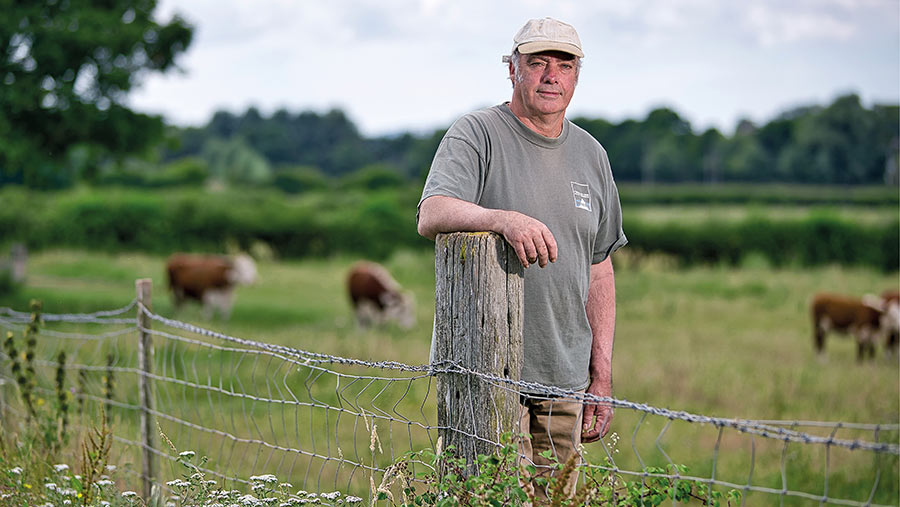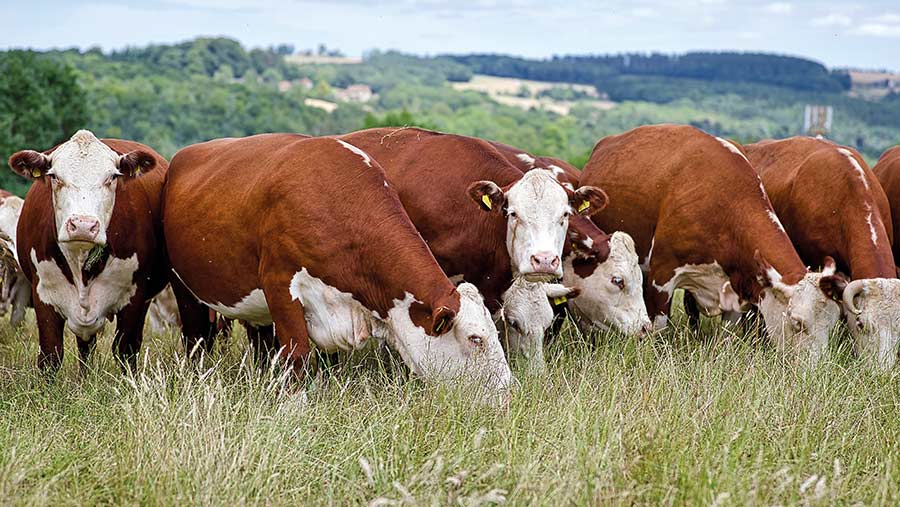7 tips for adopting a forage-based system from an award-winning beef producer
 © Richard Stanton
© Richard Stanton Simon Cutter is confident his forage-based, easy-care system of producing beef and lamb will put him on a competitive footing with low-cost producers in New Zealand, Australia, and other nations where the UK has forged free-trade agreements.
At 64, the 2022 Farmers Weekly Beef Farmer of the Year has recently scaled back his farming operation, giving two young farmers the chance to take on some of the land and stock.
He is also mentoring them in the pasture-based methods he has used at Model Farm, Herefordshire.
See also: How multispecies swards can improve production efficiency
Farm facts: Model Farm, Hildersley, Herefordshire
- Tenant farmer
- Organic, pasture-fed system
- 142ha (350 acres) farmed
- 50 Hereford cows, split-block calving
- 100 Easycare ewes
- 10 Hampshire sows
- Direct sales through farm shop
Mr Cutter reckons it is this system that will make new entrants like them competitive with low-cost producers overseas.
“I wish that when I started out in farming, I had known then what I know now,” he admits.
“Although raising ruminant livestock on a pasture-based system doesn’t suit every farm or set of circumstances, we now know that the methods used by our grandfathers were correct.”
Mr Cutter offers this advice to farmers considering adopting a grass-based approach to livestock production:
1. Consider global research
A lot of the knowledge I have gained has not come from UK research but from trials in New Zealand.
Here, farmers, researchers and geneticists work together as a team, using estimated breeding values (EBVs) and other progressive approaches, along with crowd-funding research of specialist topics.
The style of livestock farming in New Zealand is mostly less intensive because farmers have the benefit of large areas of land.
For that reason, research on pasture-based methods is way ahead of what we have here in the UK.
We need to capitalise on that research and consider how it can be applied to individual systems here.
2. Maximise plant diversity
We have grown lucerne for many years; it does not need any chemical herbicides or artificial fertiliser and the yield is very high – it grows thigh-high three times a year and we get a smaller fourth cut or grazing for lambs.
It is important to let it flower at least once during the season, which we do at third cut.
Lucerne is 20% protein, so it removes the need to buy soya – we analyse it for nutrient values and this shows that it is high in calcium too, way off the scale.
In the exceptionally dry conditions we experienced last summer, the lucerne fields remained green. The plant is deep rooting – at least 2m in our red sandstone soils – so it did not suffer from the lack of rainfall.
We have been so pleased with it that this year we will increase the area grown from 8ha to 12ha (20 acres to 30 acres).
3. Be willing to experiment
Approach pasture-based farming with an open mind and be willing to try new things.
We have experimented by adding cocksfoot to the lucerne mix for the first time, trialling it in one half of a field; it is way ahead on growth compared with the half without it.
If we had listened to the seed companies, we might have used timothy or meadow fescue instead. However, we looked at independent research, again from New Zealand, and this showed good results from incorporating cocksfoot.
We are only in our first year of growing it, so we don’t know if it will shorten the life of the ley; only time will tell. But unless we try these things, we will never know what works, and what doesn’t.
4. It all starts with the soil
We protect soils from poaching by never outwintering on the same field two years in a row.
Getting a good cover of deferred grass protects the soil and makes it healthier.
Round feeders are moved every single day; there is never an excuse not to do that, even on Christmas Day.
5. Suckler cows do not need high-quality grazing
We have found that our Herefords are best suited to cheap ground and bale grazing on poorer land.
By strip-grazing during the winter, our wintering costs are only 80p a head a day. It is the winter costs that have most influence over suckler cow profitability.
The fence is moved daily, to provide fresh grazing, along with two bales of hay allocated to 50 cows.
Our cows still have plenty of milk on them when we wean the calves at 11 months old.

© Richard Stanton
6. Collaborate with like-minded farmers
There can be a tendency in farming to hope that your neighbour fails at something, but as a founder member of the Pasture-Fed Livestock Association (PFLA), I am privileged to be part of a network of farmers who want each other to succeed.
If a farmer needs help, they post a message on the PFLA forum asking for advice. PFLA has local groups, too, to bring together people to discuss different subjects.
7. Have a back-up plan
Every farm needs a plan A, B and C, so if the first plan doesn’t work, they can default to the second and so on.
For instance, in a pasture-based system, although the ethos is to keep stock at grass come what may, there might be a reason why the animals need to be housed.
If we were to stick to the original plan of keeping them at grass regardless, we would not be considering the needs of those animals. Their welfare should always have priority, first and foremost.
Farmers Weekly Awards 2023 Beef Farmer of the Year sponsor
The Farmers Weekly 2023 Beef Farmer of the Year is sponsored by ABP Food Group.
Find more information about the Awards.

